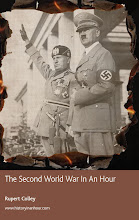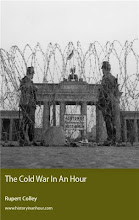On this day, January 20, in 1942, during World War Two, took place perhaps the most notorious meeting in history. In a grand villa on the picturesque banks of Berlin’s Lake Wannsee, met fifteen high-ranking Nazis.
The Final Solution
Chaired by the chief of the security police, 37-year-old Reinhard Heydrich, the fifteen men represented various agencies of the Nazi apparatus. Heydrich's objective, as tasked by Hermann Göring (and therefore, presumably, Hitler), was to secure the support of these various agencies for the implementation of the 'Final Solution of the Jewish Question', the systematic annihilation of the European Jew.
The mass murder of Jews was already taking place. The initial method of shooting Jews on the edges of pits was considered too time-consuming and detrimental on the mental health of the murder squads. The squads, often recruited from the local populations in conquered areas, willingly collaborated in the killings but eventually found the task gruelling.
Seeking alternative methods, the Germans began experimenting with gas, using carbon monoxide in mobile units but although better this was still considered too slow and inefficient. Eventually, after experiments on Soviet prisoners of war in Auschwitz during September 1941, Zyklon B gas was discovered as a rapid and efficient means of murder.
An industrial level of murder
The Wannsee Conference, as it became known, discussed escalating the killing to a new, industrial level. Heydrich estimated that 11 million Jews still resided in Europe and needed to be "combed from West to East." He produced a list of nations and their respective number of Jews, not only in countries already under Nazi control but also neutral nations and those not yet occupied. For example, Britain, according to Heydrich's figures, contained 330,000 Jews; Sweden 8,000; Spain 6,000; Switzerland 18,000; and Ireland 4,000, plus 200 Jews in Albania.
"Natural reduction"
The more able-bodied Jews, said Heydrich, would be used for labour "whereby a large number will doubtlessly be eliminated through natural reduction." Those that survived the labour, the toughest, would, if liberated, be the "core of a new Jewish revival," therefore they had to be "dealt with appropriately." The minutes of the meeting, written up by Adolf Eichmann, were littered with such euphemisms but, according to Eichmann at his trial in 1962, once the official meeting had finished, they spoke openly of executions and liquidation.
No one at the meeting objected or questioned the proposals, and Heydrich hadn't expected any but nonetheless was pleased with the level of enthusiasm. The rest of the meeting discussed definitions of ‘Jewishness’ – to what extent persons of mixed blood could be defined as Jewish; and whether children born of mixed marriages (German and Jew) were Jewish or not. And veterans of the First World War, it was decided, would be sent to ghettos specifically for the aged.
Satisfied, Heydrich drew the meeting to a close. The men retired to comfortable chairs to smoke, drink brandy and gossip whilst admiring the view over the lake. The meeting, barely an hour and a half long, was over.
The villa at Wannsee is now a holocaust museum.
Rupert Colley.
Read all about World War Two and Nazi Germany in just one hour at historyinanhour.com
Wednesday, 20 January 2010
Subscribe to:
Post Comments (Atom)






No comments:
Post a Comment